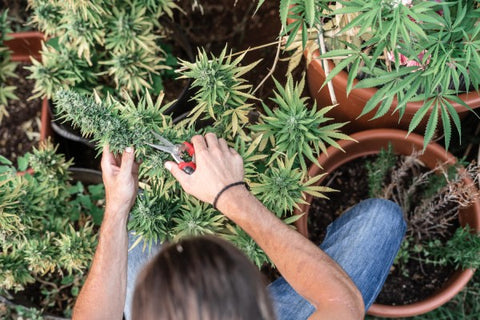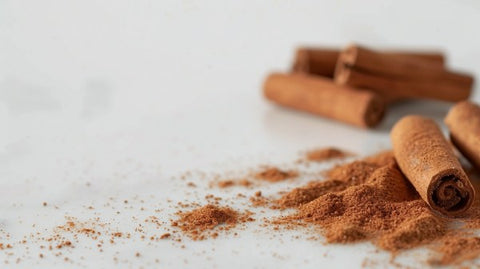
Tabla de contenidos
[HideShow]
- Origin and Properties of Cinnamon
- Cinnamon for Marijuana Plants: Benefits and Uses
- 1. Benefits for Marijuana Plants
- 2. Uses of Cinnamon in Marijuana Cultivation
- Cinnamon to Root Marijuana Plants
- 1. Cinnamon as a Natural Rooting Agent
- Cinnamon as a Natural Rooting Agent for Plants: How to Apply It
- 1. Step by Step to Use Cinnamon in Rooting
- 2. recommendations
- Additional Tips and Precautions
- 1. Maximize the Benefits of Cinnamon
- 2. Precautions and Possible Interactions
- Leave a comment
Use of cinnamon for marijuana plants
In the world of plant cultivation, the search for natural and sustainable methods to improve plant growth and health has always been a topic of great interest. Growers, both hobbyists and professionals, are constantly exploring organic alternatives that offer effective solutions without compromising the well-being of the environment or the plants themselves. In this context, cinnamon emerges, an ancient spice, known for its distinctive aroma and flavor, but also for its surprising benefits in the garden.
Cinnamon is a natural rooting agent for marijuana cuttings. Its antifungal and root-stimulating properties are beneficial. Mix cinnamon powder with water and soak the cuttings before planting to promote healthy rooting.

Origin and Properties of Cinnamon
Cinnamon, one of the oldest spices known to humanity, has played a significant role throughout history in various cultures. Native to Sri Lanka, cinnamon has been used in both cooking and traditional medicine for thousands of years. In ancient Egypt, it was valued both for its aromatic properties and for its uses in the mummification process. Beyond its culinary use, cinnamon was a luxury item in medieval Europe, prized for its exotic flavor and supposed healing properties.
Beyond its rich cultural history, cinnamon has properties that make it particularly beneficial for plants. Its essential oil, rich in compounds such as cinnamaldehyde, has antifungal and antibacterial properties , making it a natural ally in the fight against diseases and pests that affect plants. Additionally, cinnamon has been shown to be effective in promoting the rooting of plant cuttings , acting as a natural rooting agent that stimulates the growth of new roots without the risks associated with synthetic chemicals.
These properties make cinnamon an ideal choice for marijuana growers looking for natural and organic methods to improve the health and vigor of their plants. Its ability to protect against pathogens and stimulate root growth makes it a valuable tool in any cannabis garden.
Cinnamon for Marijuana Plants: Benefits and Uses
Cinnamon, more than a kitchen spice, is a treasure in the cannabis garden. Its application in marijuana cultivation offers multiple benefits, making it an essential tool for the organically conscious grower.
Benefits for Marijuana Plants
- Natural Protection Against Pests and Diseases of Marijuana : Cinnamon is known for its antifungal and antibacterial properties. This is especially useful in preventing common diseases in cannabis plants, such as powdery mildew or root rot.
- Rooting Stimulant : Being a natural rooting agent for plants, cinnamon promotes the growth of new roots in marijuana cuttings. This is crucial for the reproduction and strengthening of plants.
- Pest Repellent : Its aroma and chemical properties act as a natural repellent, deterring insects and pests without harming the environment or the plant.
Uses of Cinnamon in Marijuana Cultivation
- As a Protective Layer : Sprinkling cinnamon powder on the soil around cannabis plants can help prevent fungal diseases. This layer acts as a protective barrier.
- Treating Cuttings : When taking cannabis cuttings for propagation, dipping or sprinkling the cut ends with cinnamon powder helps encourage rooting and protect them from infection.
- Anti-Pest Spray : Mixing cinnamon powder with water and applying it as a spray is an effective way to repel pests without resorting to harmful chemicals.
- Soil Improvement : Incorporating cinnamon into the soil not only improves its quality but also provides a hostile environment for pest larvae and eggs.

Cinnamon to Root Marijuana Plants
The use of cinnamon as a natural rooting agent is one of the most prominent practices in marijuana cultivation due to its effectiveness and safety. Let's see how it works and some recommendations for commercial rooting agents.
Although cinnamon is an excellent natural rooting agent, some growers prefer commercial options for their consistency and proven results. Here we present some highly recommended commercial rooting agents:
- ClonFix by Hesi : Rooting gel with auxin hormone, ideal for plant cuttings. It encourages the sprouting of new roots and is effective in various growing media. For best results, it is suggested to use it with an electric propagator that maintains the appropriate temperature and humidity.
- Clonex Rooting : Growth Technology rooting gel, contains nutrients and 0.3% indolebutyric acid. This product ensures the effective development of the first roots and can increase the rooting level up to 99.8%. Clonex is characterized by remaining in contact with the stem throughout the rooting process, sealing the cut tissue and avoiding pathogenic infections.
- Root Riot Clonex : Growth Technology peat plugs, enriched with hormones and nutrients, designed for rooting cuttings. They provide an ideal environment for rapid root development and are optimal for use in electric propagators, keeping humidity and temperature levels controlled.
- Clonex Mist : A root stimulator spray from Growth Technology, designed to increase efficiency in the cutting rooting process. This product, applied directly to young plants and cuttings, helps accelerate root development and improves overall plant health.
- F1 Extreme Booster by BAC : This is a fertilizer specifically designed to strengthen and improve the performance of cannabis plants. Suitable for use at different stages of growth, F1 Extreme Booster helps optimize the overall health of plants and boost their development.
Cinnamon as a Natural Rooting Agent
The rooting process is crucial for the healthy development of marijuana plants, especially when propagated through cuttings. This is where cinnamon shows its true value:
- Stimulation of Root Growth : Cinnamon contains compounds that stimulate the growth of new roots. By applying cinnamon powder directly to the cut end of a cutting, root formation is encouraged.
- Antifungal Properties : In addition to stimulating root growth, cinnamon helps prevent fungal development on cuttings, a common problem during the rooting stage.
- Natural and Economical Method : Using cinnamon as a rooting agent is a natural and economical alternative to synthetic chemicals, ideal for those who prefer an organic and sustainable approach to their cannabis garden.
Cinnamon as a Natural Rooting Agent for Plants: How to Apply It
Using cinnamon as a natural rooting agent for your marijuana plants is a simple but effective process. Here I present a step-by-step guide along with some tips and best practices to maximize its benefits.
Step by Step to Use Cinnamon in Rooting
- Preparing Cuttings : Start by selecting healthy cuttings from your marijuana plant. These should have at least a few nodes and be cut at a 45-degree angle to increase rooting surface area. Clean your cutting tools with alcohol to prevent disease transmission.
- Application of Cinnamon : Place cinnamon powder on a small plate or similar. Dip or sprinkle the cut end of the cutting directly into the cinnamon. Make sure to cover the cut area well with a thin layer of cinnamon. Gently shake excess cinnamon off the cutting.
- Planting the Cuttings : Plant the treated cuttings in your preferred growing medium, whether soil, coconut fiber, or a hydroponic system. Make sure the growing medium is moist but not saturated.
- Aftercare : Keep the cuttings in a warm place with enough humidity and indirect light. You can use a plastic cover to create a mini greenhouse and maintain humidity. Avoid overwatering, as this can encourage fungal growth.
recommendations
- Quality of Cinnamon : Use good quality cinnamon. Ceylon cinnamon is generally preferred for its higher essential oil content, although regular cinnamon is also effective.
- Frequency of Use : Cinnamon can be used in each rooting cycle of cuttings. There is no risk of overdose or adverse effects on the plants.
- Combination with Other Methods : While cinnamon is effective on its own, you can experiment by combining it with other natural rooting methods to see what works best for your plants.
- Observation and Adjustments : Monitor the progress of your cuttings. If you notice any signs of disease or deterioration, adjust your care practices or consult with other experienced growers.

Additional Tips and Precautions
While cinnamon is a natural and beneficial resource for growing marijuana, it is important to consider some additional tips and precautions to maximize its effectiveness and avoid potential mishaps.
Maximize the Benefits of Cinnamon
- Moderate Use : Although cinnamon is safe, excessive use can affect water absorption in cuttings. Apply a thin, even layer to cuts or soil to avoid problems.
- Quality and Freshness : Use high quality cinnamon and make sure it is fresh. Old cinnamon can lose some of its antifungal and rooting properties.
- Combination with Sustainable Growing Practices : Integrate cinnamon into a broader growing approach that includes composting, crop rotation, and efficient water use to encourage a healthy, sustainable garden.
- Continuous Monitoring : Observe your marijuana plants regularly to identify any signs of disease or deficiency. Cinnamon can help prevent problems, but it does not replace the need for good crop management.
Precautions and Possible Interactions
- Interaction with Fertilizers and Chemicals : If you are using fertilizers or chemicals in your crop, investigate possible interactions with cinnamon. In most cases, there are no problems, but it is always better to err on the side of caution.
- Plant Reaction : As with any new treatment, watch how your plants react to the cinnamon. If you notice adverse effects, reduce its use or consult with cultivation experts.
- Use in Different Stages of Cultivation : Keep in mind that cinnamon may be more beneficial in certain stages of cultivation, such as rooting cuttings, and less in others, such as during flowering. Adjust its use according to the needs of your plants.
- Caution in Consumption : While cinnamon is generally safe for cultivation, use caution if marijuana plants are intended for consumption. Make sure there are no cinnamon residues left on the parts of the plant that will be consumed.

Leave a comment